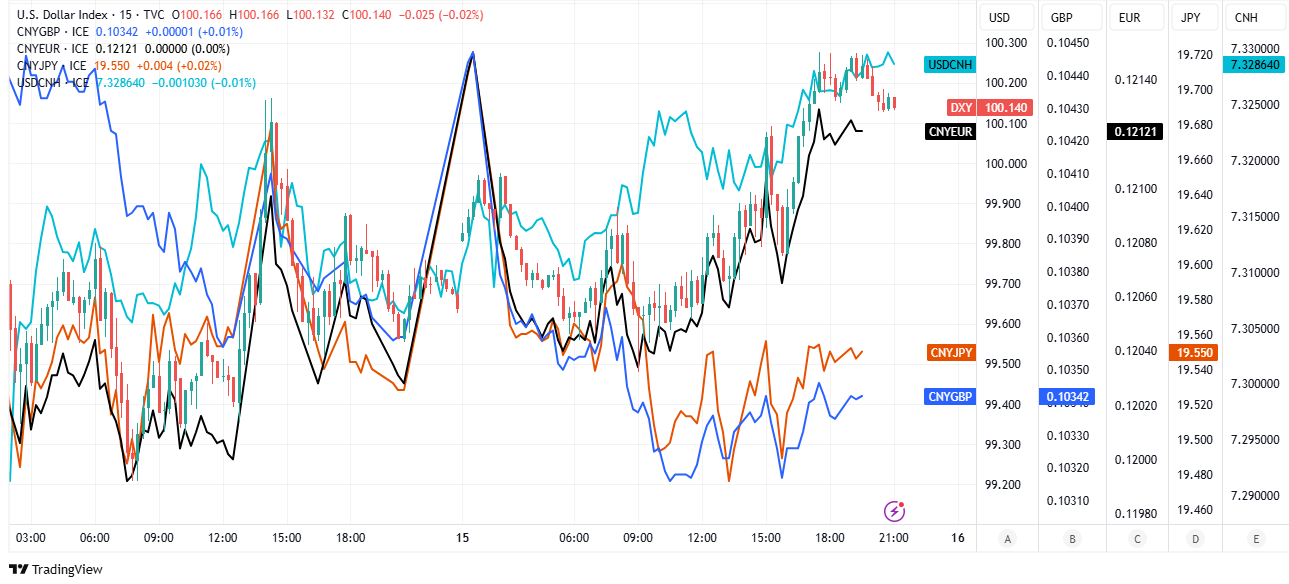
Image © Adobe Images
The US Dollar recovered off its intraday lows against many of its most traded counterparts on Tuesday amid an apparent effort by authorities in Beijing to enforce its minimum floors in numerous Chinese Renminbi pairs.
Most advanced economy currencies rose as the US Dollar fell broadly in Asia and early in the European morning until the Norwegian Krone, Swedish Krona, Swiss Franc and South African Rand turned lower.
The turns in USD/NOK, USD/SEK, USD/CHF and USD/ZAR came as the Renminbi recovered off Tuesday’s minimum floors against the Krone, Krona, Franc and Rand soon after the European open.
That, in turn, was followed by a gradual retreat in EUR/USD from Tuesday’s highs, while the Pound, Japanese Yen, New Zealand Dollar, Australian Dollar and Mexican Peso remained buoyant throughout the day.
Both AUD/CNY and NZD/CNY also later tested their upper limits in early North American trade before retreating in tandem with NZD/USD and AUD/USD, amid strong and sustained co-movements between all and each.
Above: US Dollar Index at 15-minute intervals with various RMB/CNY pairs. Click for closer inspection.
Tuesday's Dollar decline was always going to be limited after Beijing raised the central parity fixes and trading limits for 14 of the 25 currencies and some 49.53% of the China Foreign Exchange Trade System (CFETS) Index, while leaving one unchanged and lowering those for 10 others including the Swedish Krona and Euro.
Tuesday’s fixes followed a broad depreciation signal on Monday in which all 25 pairs saw their fixes lowered following a week in which both the Renminbi and Dollar came under pressure against all G10 currencies and 16 in the broader G20 basket amid an escalation of the trade spat between Washington and Beijing.
The balance of changes on Tuesday perhaps reflects a preference for the trade-weighted currency to stabilise, which would matter for the Dollar because Beijing’s basket-based approach to its managed-floating exchange rate creates a correlation and quasi peg between the two trade-weighted currencies.
"[Treasury Secretary Bessent also] reiterated his administration’s strong-dollar policy and noted he sees no evidence of sovereign sales of Treasuries,” says Dr. Win Thin, head of markets strategy at Brown Brothers Harriman.
"We look for continued dollar weakness and view any dollar recoveries as quite fragile, no matter how the U.S. data come in. Given the ongoing unpredictability of Trump administration policy, we continue to downplay any notions of a Fed response in the near term, which official comments would seem to confirm," he adds.

Above: US Dollar Index at daily intervals with various Renminbi pairs. Click for closer inspection.
Both currencies have fallen broadly since the White House’s “Liberation Day” tariff announcement prompted a tit-for-tat exchange of tariff measures, which reached a crescendo last Friday when the Ministry of Finance in Beijing added an additional 34% to its levy on imports from the US, taking the total tariff to 125%.
That is still slightly less than the 145% levied by the US on its own imports from China, however, Beijing also indicated that it might not necessarily retaliate over any additional increases made by the US, saying “At the current tariff level, there is no market acceptance for US goods exported to China.”
Global equity markets also fell heavily as economists and strategists spoke widely of how they expect the tariff spat to weigh on the US economy, while Treasury markets also saw numerous short-lived periods of simultaneous weakness amid what appeared to be frequent interventions in support of the Renminbi.
These tempered the decline of the Dollar because the restrictions on the CFETS/CNY pairs cannot be enforced without imposing implied and de facto limits on the CFETS/USD pairs, which can be inferred from the daily fixes.
Tuesday’s fixes suggested the following CFETS/USD pairs would meet pushback once rising, or falling if a USD/CFETS pair, into the ranges specified below;
USD/CNY: 7.0654/7.0654 (Previous: 7.0668/7.0668), Current Market: 7.3156
EUR/USD: 1.1386/1.1445 (Previous: 1.1402/1.1485), Current Market: 1.1287
USD/JPY: 142.15/141.41 (Previous: 142.76/141.72), Current Market: 143.15
GBP/USD: 1.3231/1.3300 (Previous: 1.3159/1.3232), Current Market: 1.3225
USD/CHF: 0.8133/0.8091 (Previous: 0.8154/0.8094), Current Market: 0.8219
USD/CAD: 1.3816/1.3744 (Previous: 1.3797/1.3697), Current Market: 1.3953
AUD/USD: 0.6361/0.6394 (Previous: 0.6322/0.6368), Current Market: 0.6345
NZD/USD: 0.5925/0.5956 (Previous: 0.5884/0.5927), Current Market: 0.5896
USD/SEK: 9.7269/9.6766 (Previous: 9.7194/9.6488), Current Market: 9.8560
USD/NOK: 10.5210/10.4667 (Previous: 10.5707/10.4939), Current Market: 10.6156
USD/ZAR: 18.8073/18.7102 (Previous: 19.0150/18.8769), Current Market: 18.8974
USD/MXN: 20.2040/20.0996 (Previous: 20.2079/20.0611), Current Market: 20.0695
USD/KRW: 1,412.73/1,405.43 (Previous: 1,443.42/1,432.94), Current: 1,425.01
USD/RUB: 20.0044/19.9010 (Previous: 82.2734/81.6758), Current Market: 82.5168

